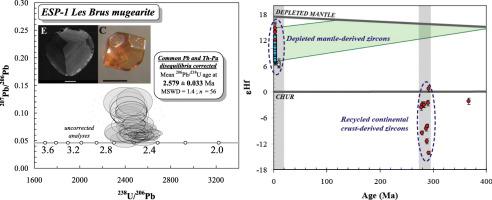当前位置:
X-MOL 学术
›
J. Volcanol. Geotherm. Res.
›
论文详情
Our official English website, www.x-mol.net, welcomes your
feedback! (Note: you will need to create a separate account there.)
Origin of zircon megacrysts in alkaline lavas (French Massif Central): Petrology and in situ U-Pb-Hf isotopes
Journal of Volcanology and Geothermal Research ( IF 2.4 ) Pub Date : 2020-07-01 , DOI: 10.1016/j.jvolgeores.2020.106907 Jean-Louis Paquette , Gilles Chazot , Abdelmouhcine Gannoun
Journal of Volcanology and Geothermal Research ( IF 2.4 ) Pub Date : 2020-07-01 , DOI: 10.1016/j.jvolgeores.2020.106907 Jean-Louis Paquette , Gilles Chazot , Abdelmouhcine Gannoun

|
Abstract In the south eastern Deves volcanic domain of the French Massif Central, we sampled red zircon megacrysts in, both, alluvium from a small stream and neighbouring mugearite lava. LA-ICP-MS U-Pb dating results yield similar ages for both suites of zircons at about 2.6 Ma. Superchondritic signatures of the Hf isotopes clearly indicate a depleted mantle source for these zircons. The mugearite lava also contains xenoliths of mantle (lherzolites) and lower crustal rocks (granulites). The chemical compositions of the minerals within the mugearite lava are similar to the mineral compositions found in these xenoliths (granulites) and granulite and peridotite xenoliths from other volcanic localities of the Massif Central. The mugearite lava also preserves Variscan zircon crystals dated at 285 Ma, originating from recycled lower continental crust. In spite of their mantle origin, as recorded by in situ Hf isotopes, the geochemistry suggests that these Pliocene zircons do not result from crystallization in the mantle or in mantle-derived mafic magmas. In order to explain this inconsistency, we propose that these zircon grains crystallized from felsic melts produced during the ultimate differentiation of mantle-derived mafic magmas in the mid or upper continental crust. Subsequently, a last basaltic batch forced its way to the surface, scavenging upper mantle and lower crust xenoliths as well as zircon xenocrysts formed in these felsic melts which partly dissolved during their ascent. Large amounts of Cenozoic zircon megacrysts are often associated with sapphires in alluvial deposits in many continental volcanic domains, not only in the French Massif Central but also worldwide. Consequently, a huge volume of felsic differentiates issued from mantle-derived basaltic magmas might be suspected in many alkaline volcanic domains at the global scale.
中文翻译:

碱性熔岩中锆石巨晶的起源(法国地块中部):岩石学和原位 U-Pb-Hf 同位素
摘要 在法国中部的德韦斯火山区东南部,我们从一条小溪的冲积层和邻近的穆格瑞特熔岩中采集了红色锆石巨晶。LA-ICP-MS U-Pb 测年结果在大约 2.6 Ma 处得出两套锆石的相似年龄。Hf 同位素的超球粒陨石特征清楚地表明这些锆石的地幔来源已耗尽。穆格瑞特熔岩还包含地幔(锂辉石)和下地壳岩石(麻粒岩)的捕虏体。穆格瑞特熔岩中矿物的化学成分与这些捕虏体(麻粒岩)以及来自地块中央其他火山区的麻粒岩和橄榄岩捕虏体中发现的矿物组成相似。穆格瑞特熔岩还保存了年代为 285 Ma 的瓦里斯坎锆石晶体,这些晶体来自回收的下大陆地壳。尽管它们起源于地幔,如原位 Hf 同位素所记录,地球化学表明这些上新世锆石不是由地幔或地幔衍生的基性岩浆中的结晶产生的。为了解释这种不一致,我们提出这些锆石颗粒是从中上陆地壳中幔源基性岩浆最终分异过程中产生的长英质熔体中结晶出来的。随后,最后一批玄武岩强行到达地表,清除了上地幔和下地壳捕虏体以及在这些长英质熔体中形成的锆石捕虏晶,这些熔体在上升过程中部分溶解。大量新生代锆石巨晶通常与许多大陆火山区的冲积矿床中的蓝宝石有关,不仅在法国地块中部,而且在世界范围内。最后,
更新日期:2020-07-01
中文翻译:

碱性熔岩中锆石巨晶的起源(法国地块中部):岩石学和原位 U-Pb-Hf 同位素
摘要 在法国中部的德韦斯火山区东南部,我们从一条小溪的冲积层和邻近的穆格瑞特熔岩中采集了红色锆石巨晶。LA-ICP-MS U-Pb 测年结果在大约 2.6 Ma 处得出两套锆石的相似年龄。Hf 同位素的超球粒陨石特征清楚地表明这些锆石的地幔来源已耗尽。穆格瑞特熔岩还包含地幔(锂辉石)和下地壳岩石(麻粒岩)的捕虏体。穆格瑞特熔岩中矿物的化学成分与这些捕虏体(麻粒岩)以及来自地块中央其他火山区的麻粒岩和橄榄岩捕虏体中发现的矿物组成相似。穆格瑞特熔岩还保存了年代为 285 Ma 的瓦里斯坎锆石晶体,这些晶体来自回收的下大陆地壳。尽管它们起源于地幔,如原位 Hf 同位素所记录,地球化学表明这些上新世锆石不是由地幔或地幔衍生的基性岩浆中的结晶产生的。为了解释这种不一致,我们提出这些锆石颗粒是从中上陆地壳中幔源基性岩浆最终分异过程中产生的长英质熔体中结晶出来的。随后,最后一批玄武岩强行到达地表,清除了上地幔和下地壳捕虏体以及在这些长英质熔体中形成的锆石捕虏晶,这些熔体在上升过程中部分溶解。大量新生代锆石巨晶通常与许多大陆火山区的冲积矿床中的蓝宝石有关,不仅在法国地块中部,而且在世界范围内。最后,











































 京公网安备 11010802027423号
京公网安备 11010802027423号